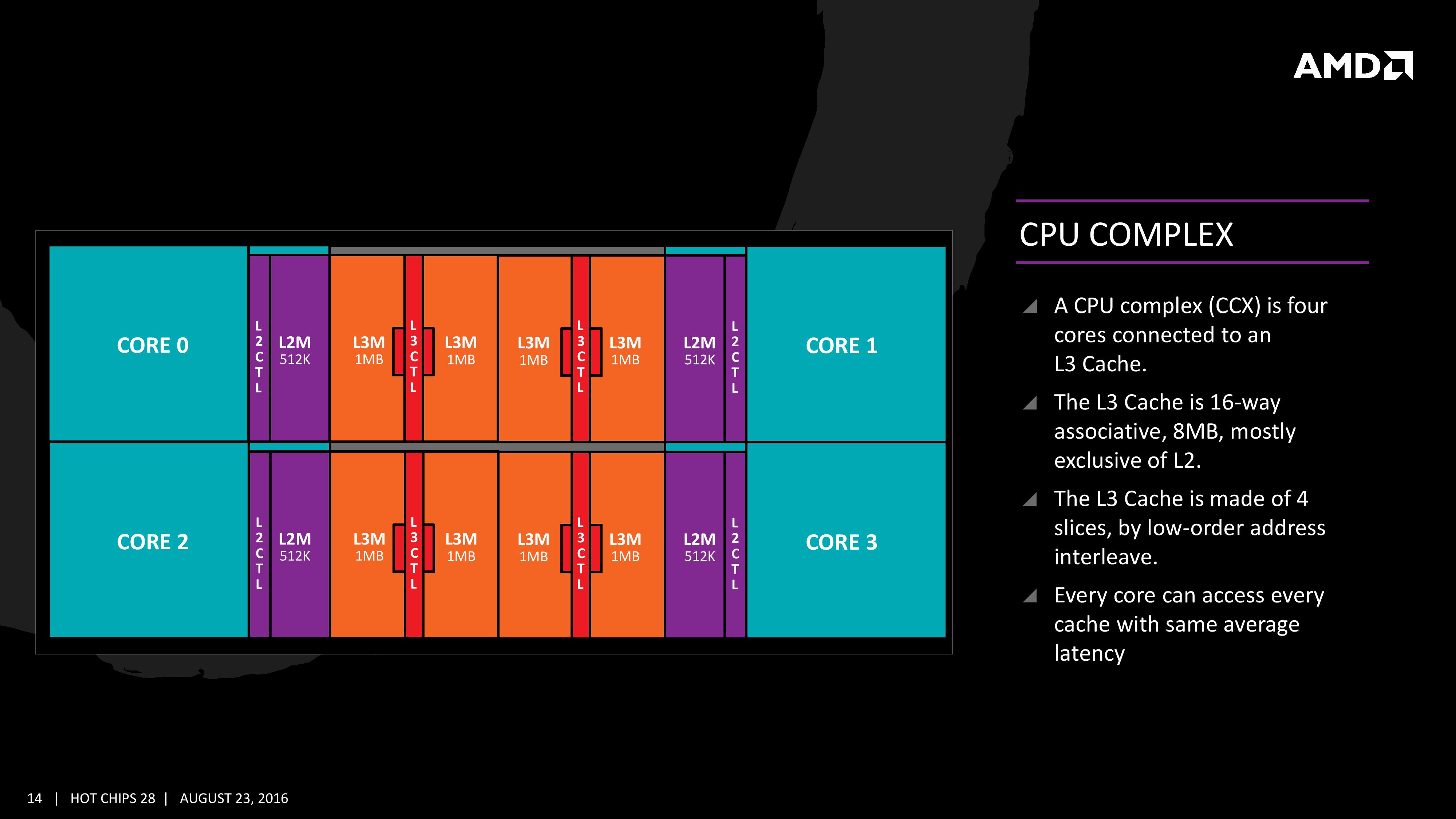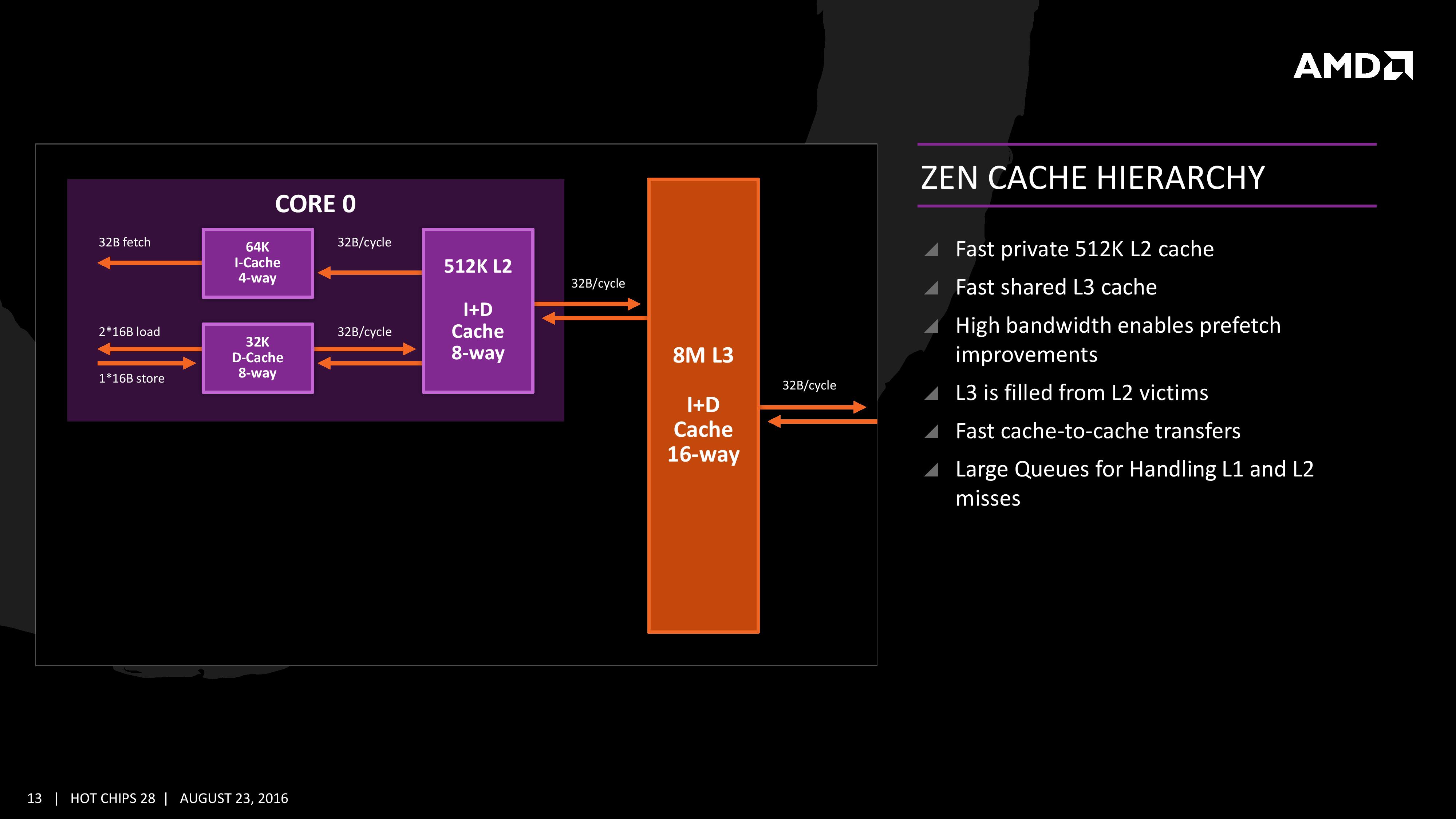The AMD Zen and Ryzen 7 Review: A Deep Dive on 1800X, 1700X and 1700
by Ian Cutress on March 2, 2017 9:00 AM ESTThe Core Complex, Caches, and Fabric
Many core designs often start with an initial low-core-count building block that is repeated across a coherent fabric to generate a large number of cores and the large die. In this case, AMD is using a CPU Complex (CCX) as that building block which consists of four cores and the associated caches.
Each core will have direct access to its private L2 cache, and the 8 MB of L3 cache is, despite being split into blocks per core, accessible by every core on the CCX with ‘an average latency’ also L3 hits nearer to the core will have a lower latency due to the low-order address interleave method of address generation.
The L3 cache is actually a victim cache, taking data from L1 and L2 evictions rather than collecting data from prefetch/demand instructions. Victim caches tend to be less effective than inclusive caches, however Zen counters this by having a sufficiency large L2 to compensate. The use of a victim cache means that it does not have to hold L2 data inside, effectively increasing its potential capacity with less data redundancy.
It is worth noting that a single CCX has 8 MB of cache, and as a result the 8-core Zen being displayed by AMD at the current events involves two CPU Complexes. This affords a total of 16 MB of L3 cache, albeit in two distinct parts. This means that the true LLC for the entire chip is actually DRAM, although AMD states that the two CCXes can communicate with each other through the custom fabric which connects both the complexes, the memory controller, the IO, the PCIe lanes etc.
The cache representation shows L1 and L2 being local to each the core, followed by 8MB of L3 split over several cores. AMD states that the L1 and L2 bandwidth is nearly double that of Excavator, with L3 now up to 5x for bandwidth, and that this bandwidth will help drive the improvements made on the prefetch side. AMD also states that there are large queues in play for L1/L2 cache misses.
One interesting story is going to be how AMD’s coherent fabric works. For those that follow mobile phone SoCs, we know fabrics and interconnects such as CCI-400 or the CCN family are optimized to take advantage of core clusters along with the rest of the chip. A number of people have speculated that the fabric used in AMD’s new design is based on HyperTransport, however AMD has confirmed that they are using a superset HyperTransport here for Zen, and that the Infinity fabric design is meant to be high bandwidth, low latency, and be in both Zen and Vega as well as future products. Almost similar to the CPU/GPU roadmaps, the Fabric has its own as well.
Ultimately the new fabric involves a series of control and data passing structures, with the data passing enabling third-party IP in custom designs, a high-performance common bus for large multi-unit (CPU/GPU) structures, and socket to socket communication. The control elements are an extension of power management, enabling parts of the fabric to duty cycle when not in use, security by way of memory management and detection, and test/initialization for activities such as data prefetch.














574 Comments
View All Comments
nt300 - Saturday, March 11, 2017 - link
The Ryzen 7 1700 is definitely the gaming choice IMO. The CPU that does well in gaming and amazing at everything else. Windows 10 hasn't been properly optimized for ZEN, so any Benchmarks and Gaming Benchmarks are not set in stone.A2Ple98 - Monday, May 22, 2017 - link
Actually Ryzen isn't for only gamers, is mostly for streamers and professionals. The cores that aren't used for gaming, they are used to encode the video you are stream. As for pro people, they get almost a i7-6900K for half the price.Sweeprshill - Thursday, March 2, 2017 - link
Does not seem to be proper English here ?Sweeprshill - Thursday, March 2, 2017 - link
n/m can't edit comments I supposent300 - Saturday, March 11, 2017 - link
Wrong, ZEN is a new design and quite innovative. Just like the past, AMD has let this industry for many years. More so when they launched the Athlon 64 with the IMC which Intel claimed was useless and a waste of die space. That Athlon 64 at 1000 MHz less clock speed smoked any Intel chip you put it against.My point, ZEN is new, and both ZEN and Intel chips are unique in there own way, might share some similarities, but nevertheless they are different.
nos024 - Thursday, March 2, 2017 - link
Nope. Ryzen will need to drop in price. $500 1800x is still too expensive. According to this even a 7700k @ $300 -$350 is still a good choice for gamers.2011-v3 still offers a platform with more PCIe3 lanes and quad memory channel. I thought about an 1800x and 370 mobo combo, but that costs similar to a 6850k with x99.
Sorry, ill stick to intel this time around. Good that ryzen caused a ripple in price war though.
Gothmoth - Thursday, March 2, 2017 - link
gamer... as if the world is only full with idiotic people who waste their lives playing shooter or RPG´s.nos024 - Thursday, March 2, 2017 - link
Ikr? Whatever makes your world go round man.brushrop03 - Thursday, March 2, 2017 - link
Well playedAndrewJacksonZA - Thursday, March 2, 2017 - link
lol